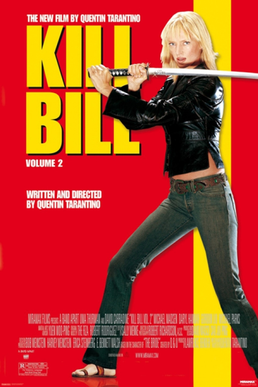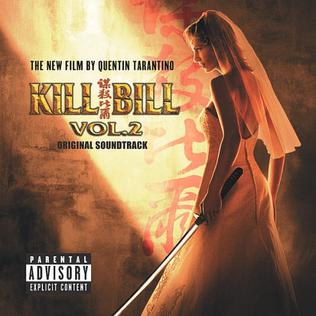
Quentin Jerome Tarantino is an American film director, screenwriter, and actor. His films are characterized by stylized violence, extended dialogue often with profanity, and references to popular culture.

Uma Karuna Thurman is an American actress. She has performed in a variety of films, from romantic comedies and dramas to science fiction and action films. Following her appearances on the December 1985 and May 1986 covers of British Vogue, Thurman starred in Dangerous Liaisons (1988). She rose to international prominence with her performance as Mia Wallace in Quentin Tarantino's 1994 film Pulp Fiction, for which she was nominated for the Academy Award, the BAFTA Award, the Golden Globe Award, and the Screen Actors Guild Award for Best Supporting Actress. Often hailed as Tarantino's muse, she reunited with the director to play the main role in Kill Bill: Volume 1 and 2, which brought her two additional Golden Globe Award nominations.

Jackie Brown is a 1997 American crime film written and directed by Quentin Tarantino, based on the 1992 novel Rum Punch by Elmore Leonard. It stars Pam Grier as Jackie Brown, a flight attendant who smuggles money between the United States and Mexico. Samuel L. Jackson, Robert Forster, Bridget Fonda, Michael Keaton, and Robert De Niro appear in supporting roles.

Kill Bill: Volume 2 is a 2004 American martial arts film written and directed by Quentin Tarantino. It is the second part to Kill Bill, and stars Uma Thurman as the Bride, who continues her campaign of revenge against the Deadly Viper Assassination Squad and their leader Bill, who tried to kill her and her unborn child.

Inglourious Basterds is a 2009 war film written and directed by Quentin Tarantino, starring Brad Pitt, Christoph Waltz, Michael Fassbender, Eli Roth, Diane Kruger, Daniel Brühl, Til Schweiger and Mélanie Laurent. The film tells an alternate history story of two converging plots to assassinate Nazi Germany's leadership at a Paris cinema—one through a British operation largely carried out by a team of Jewish American soldiers led by First Lieutenant Aldo Raine (Pitt), and another by French Jewish cinema proprietor Shosanna Dreyfus (Laurent) who seeks to avenge her murdered family. Both are faced against Hans Landa (Waltz), an SS colonel with a fearsome reputation of hunting Jews. The title was inspired by Italian director Enzo G. Castellari's 1978 Euro War film The Inglorious Bastards, though Tarantino's film is not a remake of it.

Chiaki Kuriyama is a Japanese actress, singer, and model. She is best known in the West for her roles as Takako Chigusa in Kinji Fukasaku's 2000 film Battle Royale and Gogo Yubari in Quentin Tarantino's 2003 film Kill Bill: Volume 1.

Sally JoAnne Menke was an American film editor, who worked in cinema and television. Over the span of her 30-year career in film, she accumulated more than 20 feature film credits.

Kite, known as A Kite in Japan, is a Japanese original video animation written and directed by Yasuomi Umetsu. Two 35-minute episodes were released on VHS on February 25 and October 25, 1998, respectively. However, subsequent releases, including all three DVD releases in the United States, have edited the OVA into a film.

Kill Bill Vol. 2 Original Soundtrack is the soundtrack to the second volume of the two-part Quentin Tarantino film, Kill Bill. First released on April 13, 2004, it reached #58 on the Billboard 200 and #2 on the Billboard soundtracks chart in the US. It also reached the ARIA Top 50 album charts in Australia. It was orchestrated by Tarantino's fellow filmmaker and personal friend Robert Rodriguez, as well as RZA from the Wu-Tang Clan.

Beatrix "the Bride" Kiddo is the protagonist of the martial arts films Kill Bill: Volume 1 (2003) and Kill Bill: Volume 2 (2004), directed by Quentin Tarantino. She is portrayed by Uma Thurman. In 2010, Entertainment Weekly named the Bride the 99th-greatest character of the preceding 20 years, and in 2015 Empire named her the 23rd-greatest film character of all time.

Mia Wallace is a fictional character portrayed by Uma Thurman in the 1994 Quentin Tarantino film Pulp Fiction. It was Thurman's breakthrough role and earned her a nomination for the Academy Award for Best Supporting Actress. The character became a cultural icon.

Death Proof is a 2007 American action slasher film written and directed by Quentin Tarantino. It stars Kurt Russell as a stuntman who murders young women with modified cars he purports to be "death-proof". Rosario Dawson, Vanessa Ferlito, Jordan Ladd, Rose McGowan, Sydney Tamiia Poitier, Tracie Thoms, Mary Elizabeth Winstead, and Zoë Bell co-star as the women he targets.

Zoë E. Bell is a New Zealand stuntwoman and actress. Some of her most notable stunt-work includes doubling for Lucy Lawless in Xena: Warrior Princess and for Uma Thurman in Kill Bill.

Lady Snowblood is a 1973 Japanese jidaigeki film directed by Toshiya Fujita and starring Meiko Kaji. Based on the manga series of the same name by Kazuo Koike and Kazuo Kamimura, the film recounts the tale of Yuki (Kaji), a woman who seeks vengeance upon three of the people who raped her mother and killed her half brother. The film's narrative is told out of chronological order, jumping between present and past events. Alongside Kaji, the film's cast includes Toshio Kurosawa, Masaaki Daimonm, Miyoko Akaza, and Kō Nishimura.
Double Dare is a 2004 documentary film about stuntwomen, specifically Jeannie Epper and Zoë Bell, directed by Amanda Micheli. The documentary follows Epper and Bell over several years, Epper from 1997 and Bell from the end of Xena: Warrior Princess in 2001, to 2003.

Ebony, Ivory & Jade is a 1976 film by director Cirio Santiago, made in Manila, Philippines. A relatively well-budgeted martial arts feature by Santiago's standards, the film was seen mainly in US drive-in movies, where it was first released as She-Devils in Chains. It has also been released as American Beauty Hostages, Foxfire, and Foxforce.

The Blood Spattered Bride is a 1972 Spanish horror film written and directed by Vicente Aranda, based on the 1872 vampire novella Carmilla by Joseph Sheridan Le Fanu. It stars Simón Andreu, Maribel Martín, and Alexandra Bastedo. The film attained cult film status for its mix of horror, vampirism, rejection of fascism, and progressive ideas on gender and sexuality. A well-known US trailer advertising a double feature of this film paired with the 1974 horror film I Dismember Mama was filmed in the style of a news report covering the "story" of an audience member who had gone insane while watching the films.

The Hateful Eight is a 2015 American Western film written and directed by Quentin Tarantino. It stars Samuel L. Jackson, Kurt Russell, Jennifer Jason Leigh, Walton Goggins, Demián Bichir, Tim Roth, Michael Madsen, and Bruce Dern as eight dubious strangers who seek refuge from a blizzard in a stagecoach stopover some time after the American Civil War.

Kill Bill Vol. 1 Original Soundtrack is the soundtrack to the first volume of the two-part Quentin Tarantino film Kill Bill. Released on September 23, 2003, it reached #45 on the Billboard 200 album chart and #1 on the soundtracks chart. It was organized, and mostly produced and orchestrated by RZA from the Wu-Tang Clan.

The following is a list of unproduced Quentin Tarantino projects in roughly chronological order. During his career, American film director Quentin Tarantino has worked on a number of projects which never progressed beyond the pre-production stage under his direction. Some of these projects were officially cancelled and scrapped or fell in development hell.




















